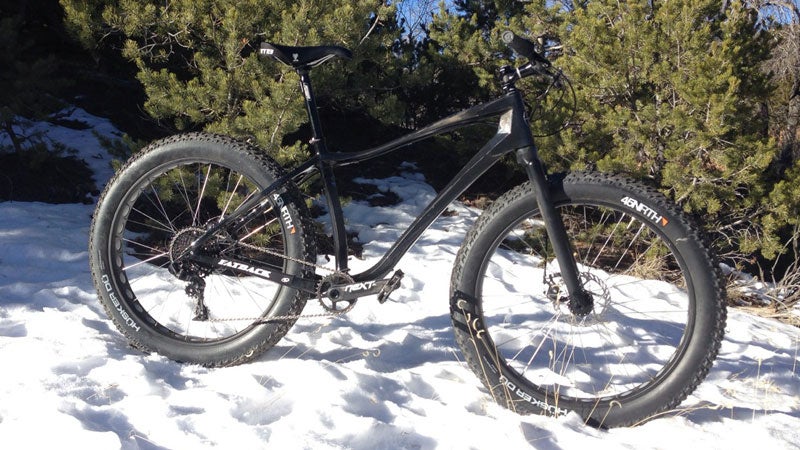A lot has changed in the four years since we rode our first fat bike, the Surly Pugsley. Whereas just a few niche companies were offering fatties at the time, there are now dozens of purveyors, including big players such as Specialized, Trek, and Kona. And while Surly’s earliest iteration was an eye-opener for us given the terrain it opened—who knew biking in snow and sand could be so much fun!?—the profusion of entries to the market have spawned innovation and lots of refinement.
Frames have evolved from steel to aluminum and, in the last year, carbon fiber. Geometries have become more agile and less monster truck. Wheels have lightened up, thanks to weight-saving cutouts in the rim face and designs that accommodate tubeless setups, while rubber options have blossomed, with everything from Surly’s new 2.75-inch Dirt Wizard all the way up to its trio of tires approaching a colossal five inches.
None of the changes are revolutionary in the context of the greater mountain bike industry. But it’s been exciting—and perhaps a bit bewildering for consumers—to see so many dramatic adaptations so quickly. Fat bikes went from goofy, quirky teenagers to all grown up over the course of just a few years.
Amid this backdrop comes the Fatback Corvus, a full-carbon machine aimed at the growing fat bike race crowd. This is not the first carbon fatty we’ve tried. That honor went to , which was followed last autumn by the Yampa from newcomer . Both are excellent bikes in their own ways. But given that the aluminum Fatback was our favorite (pre-carbon) fatty last year, I had great hopes for the Corvus. And since we climbed aboard in early January, it hasn’t disappointed.
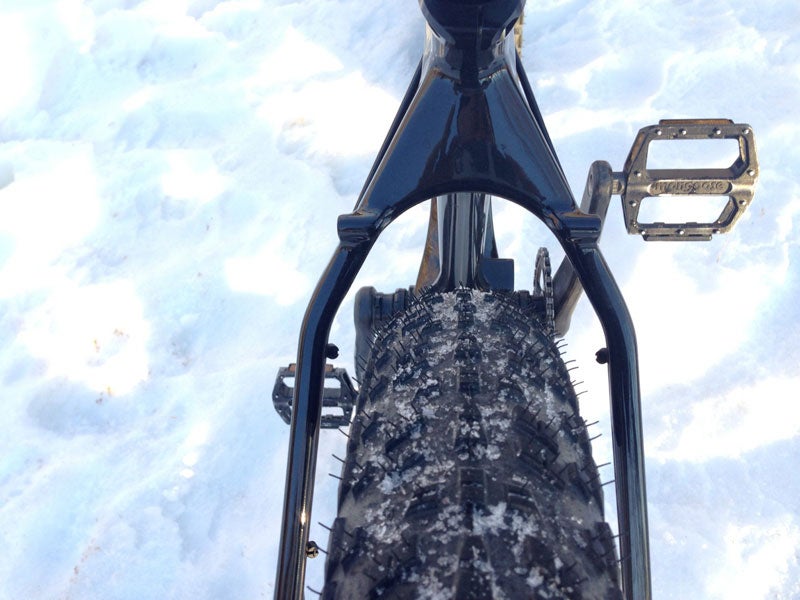
The Frame
While there are several carbon fat bike frames on the market (and more on the way, from the likes of and others), none is as sexy as the Corvus. The squared-off edges of the tubes are offset by the beautiful arcing swoop of the top and down tubes. And the graceful back-sweep of the seat tube is a nice counterpoint to the chunky, almost industrial-feeling carbon fork. Our tester was one of the first production samples off the line, and as such it didn’t get the contrast blue paint, which should make this bike prettier still. But even as it is, the Corvus is difficult to resist.
It’s not just good looks either. This frame has all the modern fixins, including a tapered head tube, post-mount brakes, direct-mount for front derailleur, and thru axles both front and rear. The latter is an important upgrade from the Borealis Yampa, which uses a quick release in the rear, a design that I feel lacks the structure and rigidity necessary for such big wheels and one that we’ve also heard of having some slippage and failure issues. And while the Beargrease offers dual thru axles, the Corvus gets our vote again for versatility since it has clearance for five-inch tires while the Salsa only allows for four inches.
The Corvus retains most of the same measurements as the aluminum Fatback, meaning the stand-over is excellent, an important consideration if you’re constantly on and off the bike with heavy boots and lots of gear. Space in the main triangle is ample, too, with two mounts for bottles in the triangle and a third on the underside of the down tube.
Other smart little details on the Corvus include built-in cable guides, rack mounts, and a molded channel for cable routing on the fork. It’s true that the Corvus lacks the internal cable routings of both the Beargrease and the Yampa, which is a shame because having lines all over the frame does detract from the beautiful aesthetic. On the other hand, external routings don’t rattle like internal ones, and they also make for easier servicing, so it’s sort of a case of picking your poison.
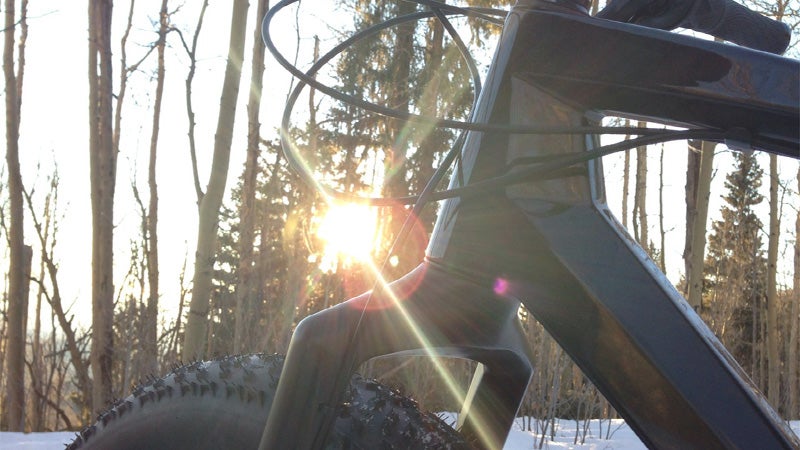
The Components
As expected for a race bike, our Corvus was hung with lots of bling. The drivetrain is a new setup, with a 32-tooth front ring and Grip Shift, which is definitely easier to handle when the fingers and thumbs get cold.
Though I have only one ring up front, attached to a pretty, light Race Face Next SL, the guys at Speedway say the bike can be run as a 2×10 instead, though not a triple. It’s worth noting that the tradeoff for going with the 190mm hub spacing to accommodate the five-inch tires is that the width of the crank is wider than, say, the Beargrease. That makes for a noticeably wide Q Factor, which is worth a bit of consideration if you have a narrow stance or finicky knees. Greg Matyas, the owner of Fatback, says he’s considering asking Race Face to produce a narrower spindle. But at the moment, if you want the option of running the fattest tires on the market, you’ll have to deal with a wide crank stance (no matter what bike you buy).
Perhaps the most alluring feature of our Corvus is its wheels, which are Fatback’s new 77mm carbon rim (70mm internal) laced to the company’s house branded Hadley hubs. I know that many people will roll their eyes and think, “Who in the world needs carbon fat bike wheels?” It’s true that these are excessive, though they’re significantly less expensive than most big brands’ carbon road and mountain bike wheels given that they’re included in the bike’s $5,500 price tag (and will be available for purchase separately for $550 per wheel). But anyway, if you are racing, you will want a pair of these. By virtue of their oversize tires, fat bikes carry a lot of weight in the wheels. Lightening up the rims with carbon makes the wheels spin up quicker and the overall ride much more lively. Fatback isn’t the only company with this bright idea: HED and Borealis are also launching carbon fat bike rims.
Last but not least are the tires, the , which I feel are the best compromise between weight and traction out there. They are “only” four inches wide, so they don’t offer the grip and spread of Surly’s awesome Bud and Lou. But they do a pretty good job in the majority of conditions and are the ideal rubber for most races.
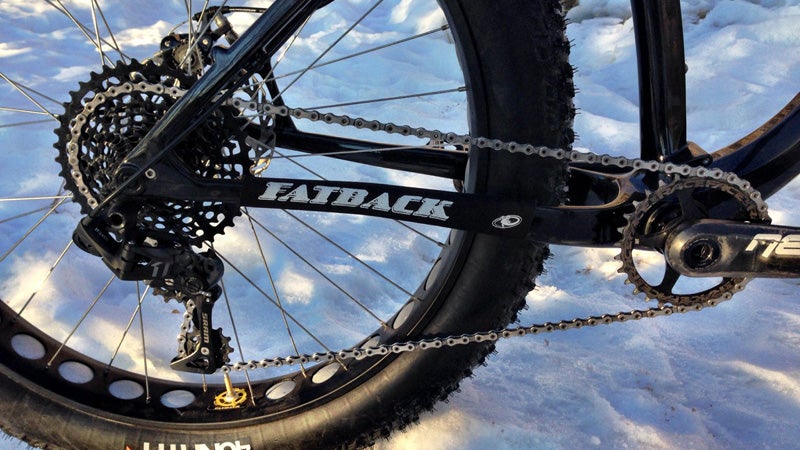
The Ride
The first thing you notice when you begin to pedal the Corvus is its weight—or more accurately, the lack of it. Our size medium tipped the scale at a meager 24.3 pounds, which is down in the realm of many hard tail mountain bikes with standard size tires. To give you an idea of just how light that is, consider that that first Pugsley we rode four years ago, which was also running four-inch tires, weighed 36.8 pounds, e.g. a full 50 percent heavier than the Corvus.
And since much of the weight savings is in the wheels, the Fatback feels like a rocket. Step on the pedals and it lurches forward, which is a bit disconcerting at first if you’re used to a stouter fatty. It’s interesting just how quick the bike is given that its chain stays are almost a full inch longer than on the Beargrease (though just a touch shorter than the Borealis). As such, the Beargrease might feel a little more explosive, though the Corvus makes up for it with the extra light carbon wheels.
The Corvus feels surprisingly like a standard hard tail mountain bike. The steering is quick but not nervous. The position in the saddle is a bit longer than on other bikes we’ve tried and seems ideal for settling in and cruising. Yet I also had no problem with the mixed terrain we get in Santa Fe, a messy combo of powder, packed snow and ice, dirt, mud and even some rock features. The Corvus dispatched most of them just fine, and I was surprised how well it clambered up and over techy rock bits, even ones that were packed out with a bit of ice.
This will sound contrarian given all the hype about 1×11 in the market right now, but I’m not convinced—at least not for every scenario. And the Corvus underscored the point. Look, I love the simplicity of skipping the front derailleur, and the engineering it took to get SRAM’s beautiful 11-speed cluster with that 42-tooth ring on top is impressive. But here’s the thing: I’m a fairly fit racer and can produce solid power, and on 1×11 setups, I find myself riding the majority of the time in the granny gear. I know that’s partly because I live in a mountainous place with lots of steep hills. Still, I’d suggest either gearing this down to 30- or 28-tooth ring up front or simply going with a two-by.
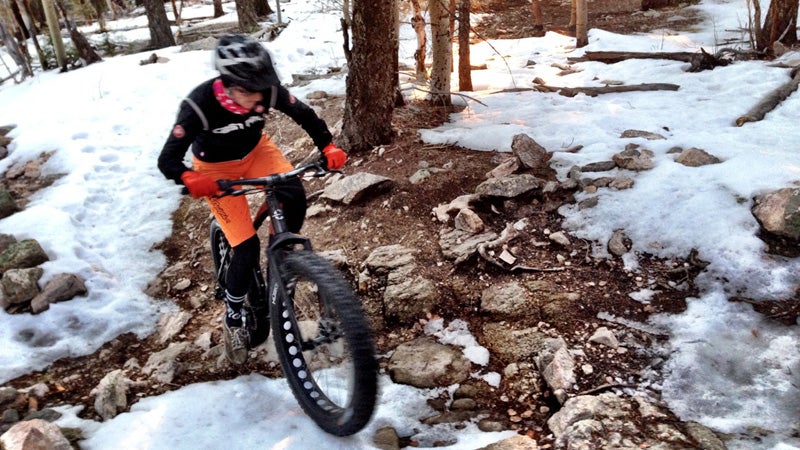
The Bottom Line
Other than niggling over gearing, a personal preference, and the consternation over the wide stance on the crank, which also harks to my personal knee issues, I can’t find fault with the Corvus. It is a gorgeous bike that’s beautifully equipped and rides like the winter wind. If I raced fat bikes, I’d probably buy one.
But that is the big “if” in the equation. Most people will look at a $5,500 carbon fat bike with carbon wheels and call it unnecessary. And just like a $10,000 road race bike or XC race bike, it is overkill for most people. In the end, this is a specialized tool that only a few people—guys racing the Arrowhead 135 and the , for instance—truly need. To wit: the three fastest guys at this year’s Alaska Ultrasport were aboard the Corvus.
Many people buy 11-pound carbon road racers and don’t actually really “need” it. They do, however, enjoy riding them. So, too, the Corvus is a great bike that will make fat biking even more fun because it’s light and fast. It’s not to say you won’t have a good time on a , which is still absolutely an awesome bike and costs 70 percent less. The difference between the two bikes is like the difference between a BMW Dakar Rally Car and a stock Jeep Wrangler, and clearly there’s a place in the market for both.
The Corvus represents the cutting edge of fat bikes at the moment. And whether or not you need one or buy one, it’s easy to appreciate it for the craft and progress it represents. And it’s one hell of a fun ride to boot.


